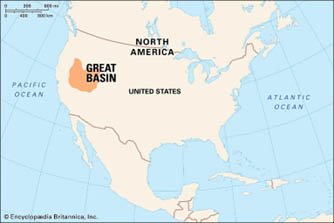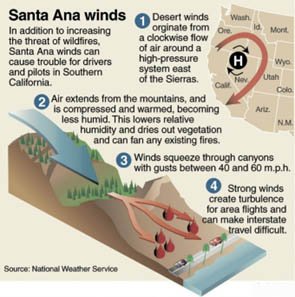SANTA ANA WINDS
- Firefighters are still fighting a wildfire in Malibu, California, which started on December 9, 2024.
- The fire, called the Franklin Fire, has burned more than 4,000 acres of land and affected around 22,000 people.
- Officials have said it will take a few more days to fully control the fire, which was 20% contained as of 12th December 2024.
- While the cause of the fire is still unknown, experts believe that two factors played a big role in making this fire so destructive: the Santa Ana winds and climate change.
WHAT ARE SANTA ANA WINDS?

- Santa Ana Winds occur when there is high pressure in the area known as the Great Basin, which is located between the Rocky Mountains and the Sierra Nevada mountains.
- At the same time, there is low pressure along California’s coast.
- This difference in pressure causes powerful winds to move from the Great Basin’s inland deserts, across the mountains, and towards the Pacific Ocean.
- As the winds move down the mountains, they compress and heat up.
- The air becomes very dry, with humidity dropping to less than 20% or sometimes even less than 10%.
- This extremely dry air makes plants and trees lose moisture and become very dry—which makes them more likely to catch fire.
- Timing of the Winds: These winds usually happen from October to January, as winter weather patterns cause high pressure to build in the Great Basin.
- This interacts with low-pressure air over the Pacific Ocean.
HOW IT AIDS WILDFIRES?

The dry air from the Santa Ana winds in Malibu made the vegetation ready to catch fire quickly, fueling the Franklin Fire.
ROLE OF CLIMATE CHANGE
- Wildfires Are Natural: Wildfires, especially those driven by Santa Ana winds, are a natural part of California’s environment.
- However, in recent years, the wildfire season has become longer and the fires have gotten stronger.
- Longer Wildfire Seasons: A 2021 study published in the journal Nature Scientific Reports found that the wildfire season in California has grown longer over the past 20 years.
- It also found that the peak of wildfire season has shifted from August to July.
- More Intense Fires: According to a 2023 study in the Proceedings of the National Academy of Sciences, 10 of the largest wildfires in California’s history have occurred in the past 20 years. Five of those happened in 2020 alone.
- Climate Change’s Impact: These changes have mostly been caused by climate change.
- As the world’s temperatures rise, we experience warmer springs and summers, as well as early snowmelt in spring.
- These changes create longer dry seasons, which put more stress on plants, making them more likely to catch fire.
- This has made California’s forests and other areas more vulnerable to wildfires.
- Future Projections: The problem will likely continue to get worse unless greenhouse gas emissions are reduced. A recent United Nations report warned that if current climate policies continue, global temperatures will rise by more than 3°C by the end of the century. This is more than twice the 1.5°C limit that world leaders have aimed to stay below.
Note: Connect with Vajirao & Reddy Institute to keep yourself updated with latest UPSC Current Affairs in English.
Note: We upload Current Affairs Except Sunday.


